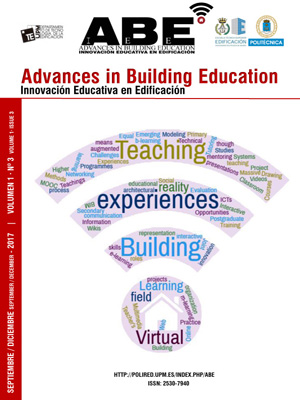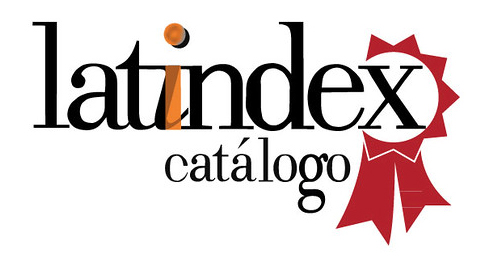Implantación de metodología BIM en el Grado de Edificación. Modelo de taller-integrador en la asignatura de Expresión Gráfica de Tecnologías = Implementation of BIM methodology in the university Degree of Building. Model of workshop integrator in the subject of graphic expressions of technologies.
DOI:
https://doi.org/10.20868/abe.2017.3.3668Keywords:
Metodología BIM, Integración interdisciplinar, Trabajo Colaborativo, BIM Methodology, Interdisciplinary Integration, Collaborative WorkAbstract
Resumen
El concepto de BIM implica un cambio radical en la manera de afrontar el diseño arquitectónico y el proceso de ciclo de vida del proyecto y del edificio. Se trata de un sistema eficiente y abierto de comunicación y cooperación entre los distintos operadores del proceso constructivo y, por tanto, idóneo para su implantación en las Escuelas Técnicas de Ingeniería y Arquitectura. Esta comunicación defiende el reconocimiento de la metodología BIM como instrumento de trabajo colaborativo y coordinado para su aplicación en la docencia, a fin de que el flujo de información interdisciplinar sea eficiente. Se describe la experiencia de la implantación de esta metodología en el Grado de Edificación, a través de un modelo de taller-integrador en la asignatura de Expresión Gráfica de Tecnologías. Posteriormente, se recogen experiencias docentes derivadas de la innovación desarrollada, que llevan a seguir apostando por esta integración tecnológica, para cuya mejora se aportan finalmente una serie de recomendaciones.
Abstract
The concept of BIM implies a radical change in the way of facing the architectural design and the life cycle process of the project and the building. It is an efficient and open system of communication and cooperation between the different operators within the construction process and, therefore, suitable for its implementation in the Technical Schools of Engineering and Architecture. This paper defends the recognition of the BIM methodology as a collaborative and coordinated tool for its application in teaching, so that the flow of interdisciplinary information is efficient. The experience of the implementation of this methodology in the Degree in Building is described, through a workshop-integrator model in the subject called Graphic Expression of Technologies. Subsequently, educational enquiries derived from the innovation developed are collected, which lead to continue supporting this technological integration. Finally, a series of recommendations for its improvement are provided.
Downloads
References
E. Nieto Julián, “Implementación de las nuevas técnicas de levantamiento en el sistema BIM (Building Information Modelling)”, XII Congreso Internacional de Expresión Gráfica Aplicada a la Edificación, Congreso APEGA, Madrid, España, vol. 12, no. 1, pp. 318–328, 2014.
E. Nieto Julián, “Experiencia integradora de la tecnología BIM en la ETSIE de Sevilla, EUBIM, Encuentro de usuarios BIM 2014. 2º Congreso Nacional BIM, pp. 257-269, 2014.
Level Of Development Specification, August 22, 2013. http://bimforum.org/lod/.
F. Rico Delgado, “A novel approach to the management of point clouds derived from scanning and photogrammetry for the optimisation of printable 3D formats. [Un nuevo enfoque en la gestión de nubes de puntos obtenidos por escáner y fotogrametría, para la optimización de formatos imprimibles 3D]”, Construir, Soñar. Drawing, Building, Dreaming, cap. 77, pp. 1051-1066, Tirant lo Blanch, 2016.
N. Harsha, “The Scope of Rapid Prototyping in Civil Engineering”, International Journal of Engineering Trends and Technology (IJETT), 4(8), pp. 3506-3508, 2013.
T. Modeen, “CADCAMing: The use of rapid prototyping for the conceptualization and fabrication of architecture”, Automation in Construction, 14(2), pp. 215-224, 2005.
I. Oliver-Faubel, “BIM en el grado de edificación: la experiencia de la escuela técnica superior de edificación de la universidad politécnica de Madrid”, Spanish journal of BIM, nº16/01, pp. 44-46, 2016.
J.Vázquez-Rodríguez, “Incorporación de herramientas paramétricas para La generación y análisis del modelo virtual del Edificio en la formación de los estudiantes de Arquitectura”, Spanish journal of BIM, nº16/01, pp. 22-27, 2016.
Downloads
Published
Issue
Section
License
ABE (Advances in Building Education / Innovación Educativa en Edificación) does not charge authors for processing or publishing an article and provides immediate Open Access to its content. All content is available free of charge to the user or his institution. Users are permitted to read, download, copy, distribute, print, search or link to the full text of articles, or use them for any other lawful purpose, without prior permission from the publisher or author. This is in accordance with the BOAI definition of open access.
- Authors retain the copyright and grant to the journal the right to a Creative Commons attribution / Non-Commercial / Non-Derivative 4.0 International (CC BY NC ND) License that allows others to share the work with an acknowledgement of authorship and non-commercial use.
- Authors may separately establish additional agreements for the non-exclusive distribution of the version of the work published in the journal (for example, placing it in an institutional repository or publishing it in a book).
Unless otherwise indicated, all contents of the electronic edition are distributed under a Creative Commons license.














